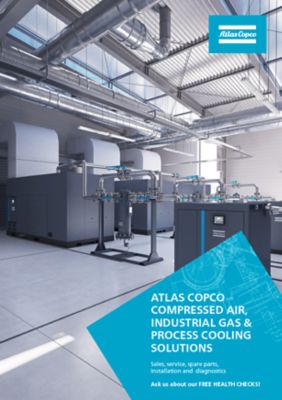5 things to consider when designing your compressor room
Although the majority of today’s air compressors and all relevant accessories can be purchased as fully-integrated, plug and play packages, it is important to remember that the installation method and siting may still have a significant influence on a compressor system’s performance and reliability.
1. Go for a dedicated and centralised compressor plant close to the point of use
2. Ensure enough space and proximity to auxiliary equipment
Essentially for large installations with lengthy pipework runs, the centralised compressor facility should be sited for optimum routing of the distribution system. Ensure there is enough space for easy service and maintenance access and try to situate the installation close to supplementary equipment such as pumps and fans – even to the boiler room. Ensure enough clearance height so that lifting equipment can handle the compressor’s heaviest components, such as the electric motor. The room should ideally also have enough floor space to install an extra compressor for backup or future expansion. Provision of drainage is equally important in order to handle condensate from compressors, aftercoolers, dryers, air receivers. Finally, take into account local regulations for waste disposal.
3. Ensure clean intake air
4. Ensure proper room ventilation
Because compressors generate heat, adequate compressor room ventilation is vital. Ventilation air should be drawn in from the exterior of the building at a maximum velocity of 4 m/s, preferably without extensive ducting and, where possible, the inlet should be positioned on a north-facing wall to provide shade in the hotter months of the year. Grille and air stream damper units prevent foreign objects from entering and they eliminate cold draughts. The intake needs to be positioned as low as possible on one wall while thermostatically-controlled ventilation fans should be sited at the highest point on the opposite wall. Always consult an expert when choosing ventilation methods; many good installations have been spoilt by incorrect cooling methods.
5. Adhere to health and safety regulations
Consider disturbance due to noise or the compressor's ventilation requirements, the provision of drainage, hazardous surroundings, e.g. exposure to dust or flammable substances and aggressive materials in the air. If the compressor is sited in an area of a building that is used for other purposes or near to staff who are carrying out other duties, then their health and safety needs to be taken into consideration, as well as accessibility for service. In order to ensure the optimum performance and reliability of compressor equipment, as a vital part of the production process, it is important to take all of these considerations into account when designing a compressor room installation. Equally important is to work with a reliable partner for your air compressor installation. Experienced engineers from Atlas Copco and its distributors will go the extra mile to ensure that installation of the compressed air package takes into account the specifics of your site.

